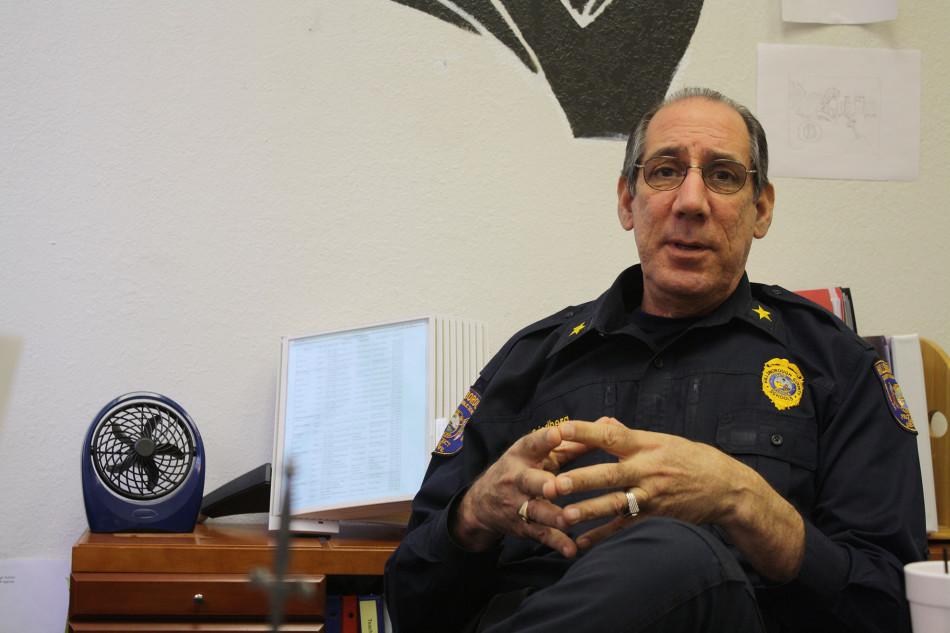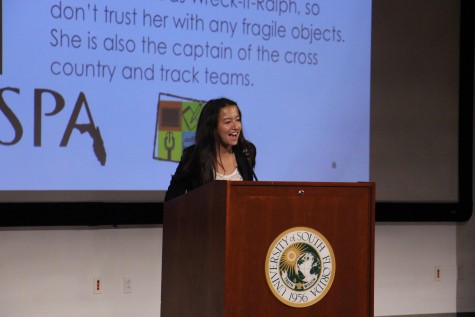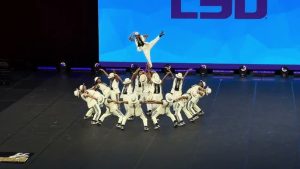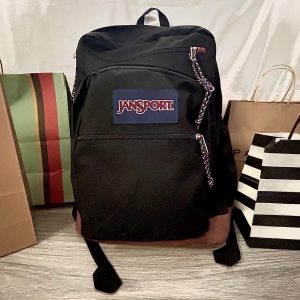Investigative Report: School Safety
February 28, 2014
All three parts of a series on safety and security in schools.
It’s the middle of C lunch, about 12:45, and Principal Johnny Bush is on patrol. Walking up and down the breezeway, he monitors the mostly empty halls. He scans every student that passes him, making sure the only people walking around in his school are the ones who have permission.
“Where’s your pass?” he asks of one student.
“Where are you headed?” he asks the other.
Checks like this are standard. The administration has a rotation so that every class period, there is at least one administrator walking around campus, checking halls.
But 21st century school safety is not limited to these hall checks. Securing school campuses is an ever-changing and complex practice, with many different methods and views all aimed at the same purpose – keeping the fifty million school children and their teachers and staff safe.
PART I: THE EVOLUTION OF SCHOOL SECURITY
While hall patrolling may be an everyday occurrence in schools today, it has not always been that way. Perhaps no one in the Hillsborough County School District knows this better than Chief David Friedberg. Friedberg has been the head of security for Hillsborough County since 1993, over 20 years ago, a time before the major school shootings of Paducah, Columbine and Sandy Hook. When he took office, the district had about 150 schools, compared to the 266 schools it has today and was just starting to implement security measures, like fences.
“Certainly there have been changes, society has changed over the years,” said Friedberg. “Columbine occurred in 1999, April 20th of 1999. The night prior I was at Gaither High School doing a presentation at a PTA meeting, and we were talking about random metal detection searchers we had just implemented.”
One of the parents questioned Friedberg. They asked specifically why random metal detection was necessary and even questioned wheher it was a violation of kids’ rights.
Friedberg countered.
“I said, ‘I’m glad you’re asking me today why we are doing something proactive because God forbid something happens terrible,” he said. “And then you’re going to ask why we didn’t do anything.’ And the funny thing is since April 20th, 1999, no one’s asked me that question.”
While Friedberg knows that the levels of school security have increased in the district over the years, especially after events like Columbine, he also points to the fact that violence in American schools has, on a whole, decreased in the past 20 years.
According to data from the National Center for Education Statistics, violence in schools reached its peak in 1993, when there were 42 homicides and 13 “serious violent crimes”: rape, sexual assault, aggravated assault, or robbery, per 1,000 students, affecting 5.5% of the student population. In 2010, the most recent data available, the numbers were 2 homicides and 4 violent crimes per 1,000 students, a 4.9% decrease.
Even with a decrease in violent incidents, the increased media presence changed the general public’s perceptions on school violence.
“Back in the day, during the Vietnam War, I remember watching Geraldo Rivera report in New York, and he would keep us informed about what was going on in Vietnam at the time, but their current information was two weeks old,” he said. “When Columbine happened, when Newtown happened, we had media coverage and the media was on scene, taking pictures. You’re sitting there watching TV, watching these things unfold, thinking, in one respect, ‘It’s happening in my own backyard’.”
With increased coverage and changing perceptions, the media continues to change the way the public views school security, consequently changing how schools need to be secured. Friedberg and his staff have a responsibility to provide a safe environment to all of the district’s 200,000 plus students and staff, making sure that the campus not only is safe, but also feels as safe as possible.
“Perceptions are real. They may not be reality, but they are true to one believing it,” said Friedberg. “If you really are safe, but don’t feel safe, I have work to do.”
And as for the best strategy for school safety? Gates, buzzers, and lights are all good, according to Friedberg, but open lines of communication between students and adults are key.
“Everybody that’s here has a responsibility for safety. It’s not just the principal, it’s not just the assistant principals, it’s not just the teachers, it’s all of us, including our students, [that must] speak up if you hear something, if you see something,” he said. “There is a saying, ‘it takes a village to raise a child.’ I believe it takes that same ‘village’ to keep us all safe. If we know what [is] happening, we have a much better chance to prevent incidents from threatening us.”
Do you feel safe at school? See the results of the survey here.
PART 2: SECURING THE SCHOOL AND LOCKED DOORS
Securing a campus of 1,573 students is no easy job, but it is the number one priority for Principal Johnny Bush. With the help of funding from the district security department and Robinson High School Foundation, and the money budgeted for security, new security measures will be put in place to help make the campus more secure: additional security cameras, fences put up around senior picnic area running up to the baseball field, brighter lighting around the neighborhood, and a push key entry that will require visitors to buzz in before coming on campus. “I don’t know if you can be too safe anymore. I’d be untruthful if I said that I don’t think about each night positive things that we got through the day with all these kids and all these teachers and other employees here,” said Bush. “You don’t sit easy when something happens at another school or [when] another school goes into lockdown. The wheels in your head start turning. It’s kind of nerve-wracking.”
For Bush, incidents like those at Sandy Hook have made him more aware of the security measures needed to be put into place. “Absolutely it does make you feel more unsafe,” said Bush. “It’s unfortunate that people have to hear about something in order to take safety measures, and I’m included. You don’t hear anything about texting and driving until someone dies, and then you want to pay more attention to it. So [now] I’ve made a cognizant effort to not distracting myself when I’m behind the wheel of the car. Same thing with the school, we’ve made more of an effort to be walking around now, and I shoot out emails to tell teachers, hey, lock your doors, take safety measures, and take care of the children that belong to other people.”
According to Bush, all teachers should have their doors closed and locked during class time. But a survey done by RHS journalism students testing 128 doors and 79 classrooms at Robinson showed that not all teachers followed this directive. Done during the 7th period for traditional teachers and period 14 for IB teachers, each doorknob was tested to see whether it was locked, and any open doors were also recorded. The survey was done without prior notice given to teachers as to get the most accurate data possible, and all doors were tested in the same time frame and day, about 2:05-2:20PM. Of the 79 classrooms, the majority, 41 classrooms, (51.9%) had one or more unlocked or open doors, and 38 classrooms were completely locked (48.1%).
Differences between IB and traditional classrooms differed greatly. Of the 24 IB classrooms, the majority, 12 classrooms (50%), were unlocked. Only 4 (16.7%) were completely locked. In the 54 traditional classrooms, the majority, 33 classrooms (61.1%), were completely locked. Only 11 (20.4%) were completely unlocked, over half the percentage of unlocked IB classrooms.
Craig Everhart, an IB Biology teacher, had one door open and the other unlocked during the survey. “I keep my doors locked for every class except JA (an IB study hall) because [in JA] people are constantly coming and going between electives and other classes and someone would always have to get up to get the door. In JA, I am not teaching and can keep an eye on who is coming in and out,” said Everhart, who, during the survey, had a research class. “During my other classes it [keeping the doors locked] helps because it limits the students coming in and out of class.”
In the social studies hallway, rooms 241-251, 10 classrooms were unlocked, and only one classroom- Kevin McCray’s- was locked. “It’s what we are told to do. It’s a nuisance that if a student has to come into class [late] it’s a disruption,” said McCray. “[But] certainly if something did happen and it prevented a kid from getting injured, it’d be worth it.”
And locked doors can help in prevention and securing classrooms in the unlikely event of an active shooter; in the Sandy Hook shooting, both of the classrooms shooter Adam Lanza went into were unlocked, and when faced with a barricaded interior door that the teacher would not open after he yelled, ‘Let me In!’, he did not attempt to use force to get inside.
With situations like school shootings in mind, Bush offered a last piece of advice to teachers who keep their doors unlocked. “It doesn’t happen very often. But, if [a situation like an active shooter] did happen, they’d feel very bad; if something as simple as locking a door could have prevented it.”
*********************************
A boy in a sweatshirt sits outside on a bench near the main office. Principal Johnny Bush has been watching him for a couple of minutes now, and, noticing he hasn’t moved at all, strides over to the boy.
“Young man,” he says, “What are you doing?”
The boy looks up, says something about going to his locker, but he’s been sitting there for a while now, and Bush knows it.
“Where are you supposed to be?” he asks. The boy tells him lunch, and Bush waves him in the direction of the cafeteria.
“Go back to lunch,” he says. “And don’t let me catch you out here again, or you’ll be in trouble.”
PART 3: OPINION: DEFINING SCHOOL SECURITY
When I interviewed school security Chief David Friedberg for an article on Robinson’s security, he asked me one question: Do you feel safe in school? Then, it took me by surprise. Did he really think that I could answer him anything but yes? I didn’t feel unsafe at Robinson, but even if I did, would I really say that to the head of security? And, who was I, a ninth grader, to comment on the security of the school? We are fenced in, we have cameras, and we have an on campus police officer. Beyond the small changes he mentioned being made, what else could they really do? There are only so many walls, gates, and security one can give a school before it becomes more prison than school.
Six days later, my backpack, along with my laptop, phone, and calculator, was stolen while I was in the bathroom.
I was shocked. I had been at Robinson for just a little over a semester, but already I felt comfortable in the school. Call me naïve, but I was in disbelief. What irked me even more was the fact they took my whole backpack. Stealing the laptop and phone would have been easier anyways, did they really need my planner, my CAS forms, or my snack for track practice that day? During the last hour and a half of that day, I tried to keep my calm, but all I felt was anger. Anger at myself for leaving the backpack out of my sight. Anger at the people who stole it. But mostly, I was angry because of what I would never get back, what they stole from me.
In the days following, it was the smaller items, little personal effects the thieves wouldn’t have cared about, that really got to me: when I reached for my stapler to turn in a paper and I realized it wasn’t there, when I had to rewrite Biology vocabulary, and when, ironically enough, I realized that of that I had lost all but 17 out of the 50 minutes of Chief Friedberg’s interview. The rest is probably long gone, the biggest interview, so far, of my journalistic career erased, along with everything else on my phone, in a couple of taps by people who didn’t know its importance.
After the theft, my mind drifted to the question Chief Friedberg asked me only days before. Did I still feel safe at school? Did the theft really change my perceptions? I couldn’t deny the fact I never wanted to let my backpack leave my sight, that every time I walked down the math and science hallway, I would eye people who I didn’t know and wonder, Was it them? It made me notice things I would have dismissed before; about a week after, a friend walked into the bathroom as I was leaving and dropped her backpack where mine was stolen, walking into the stall before I could say anything. I stood next to her bag like the backpack police until the line for the bathroom became so long that people stood crowded around the bag, snaking out into the hallway, and I knew no thief could steal it unspotted. Clearly it had changed me.
What I is realized is safety isn’t black and white. How to keep students safe, especially with the recent shootings, is an ever-evolving topic in which everyone seems to have different methods. There is no one size fits all, no fix-all solution that stops any and all incidents. No amount of gates, buzzers, or lights will help if it’s a student already in the school at fault.
So by that standard, I do not feel quite as safe in school anymore. It is not that I feel unsafe, necessarily, but more untrusting. I used to trust that my backpack would be safe, but now I bring it into the stall. I used to think a student would not be as mean as to take my whole backpack, to steal things that they had no use for, but whoever stole my backpack proved me wrong. And I know it is a small percentage of students who are like that. It is that small percentage of students who stole my backpack, leaving my colored pencils and USB drive in a backyard in Lutz, my backpack in a dumpster behind a law office on Busch Boulevard, and taking my sense of safety with them.
When people think about school security, the idea that pops into their head first probably has to do with the recent shootings. With tremendous attention from the media, and the politicians that are quick to proclaim their stance in the gun control debate, it is hard to ignore.
The truth is, however, school safety isn’t solely based on protecting students from a terrorist, disgruntled teacher, or student with a grudge. The majority of schools in the country will never have to cope with a Newtown-like situation, but theft, fighting, or vandalism are security issues that every school addresses. When defining the safety of a school, it is our responsibility to look not only at how well equipped it is for those unlikely scenarios like an active shooter, but also how it responds to and combats common occurrences, like theft. Any one of those incidents, no matter how seemingly insignificant in the big picture, have the power to hurt its victims, and no student, teacher, or staffer should have to walk on campus feeling unsafe.











